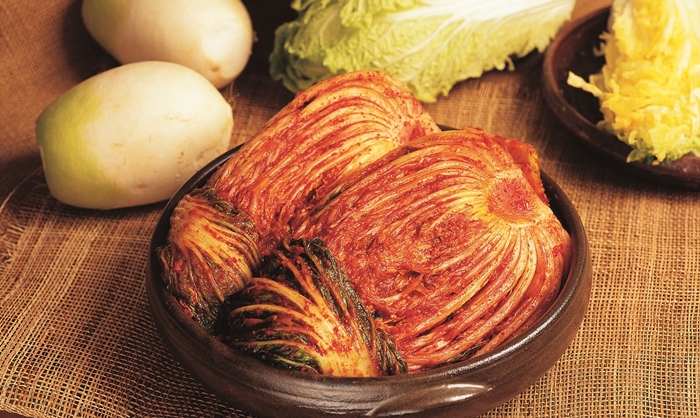
In late autumn, kimchi is prepared for the winter. (Korea Cultural Heritage Foundation)
By Kang Gahui and Hahm Hee-eun
The kimchi-making season is back this year.
In late autumn, families gather for kimjang, also spelled as gimjang in the new Romanization system, an important annual event for preparing kimchi to last the whole winter.
The kimjang day is a special day that reflects upon a long community tradition that not only brings families together but also neighbors. Several hundred cabbages are bought, cleaned, salted and mixed for each household. The finished kimchi heads are stored in a huge earthenware pot, which is kept in the ground. When the whole process of kimjang is finished, neighbors and families enjoy freshly made kimchi with oysters and boiled pork slices.
This tradition still continues in the countryside, while in the cities, there is a new change among younger people. As the social lifestyles change with increasing numbers of nuclear families and single households, the kimchi consumption pattern has also changed.
First of all, the process of adding salt to cabbages has been replaced with simply buying salted cabbages. Now the whole process of making kimchi, which took around two to three days, has been shortened to a day since the most important and difficult part of the kimchi-making process has been omitted. Moreover, the amount of kimjang has also decreased to around 20 heads of cabbage per family of four. Now all they have to do is to mix the kimchi sauce with salted cabbage. Then the finished kimchi goes to a kimchi refrigerator that is equipped with a customized function for fermenting kimchi.
The head of Research and Development Division at the World Institute of Kimchi, Park Chae Lin, said, “The simplified kimjang trend not only helps kimjang beginners but also professional kimchi makers to continue the tradition of kimchi-making.” She added, “Although buying ready-made kimchi products has increased in recent years, more than 70 percent of Koreans still make their own kimchi or receive kimchi from their relatives.”
Well-packed kimchi products are easily available in markets and online malls, but Koreans still prefer to make Kimchi and share it with their families. Why does such kimjang custom continue in today’s Korean society?
Better tasting and healthier ingredients are not the only reasons. The kimjang custom is a unique part of the Korean cultural heritage that promotes sharing and community-building that goes beyond mere food preparation. Kimjang was listed on the Representative List of the Intangible Cultural Heritage of Humanity in 2013, showing that it is a part of Korean people’s life. Through the kimjang custom Korean people have developed their identity, sense of belonging and solidarity.
In today’s society, individualism has spread and the bonds within the community have broken down. Kimjang, the time of preparing kimchi, is what’s needed for us at this time, to feel the virtues of sharing with our relatives and neighbors.
kgh89@korea.kr
Most popular
- Military discharge sets stage for reunion of all 7 BTS members
- Lee Jae-myung officially sworn in as nation's 21st president
- Presidents Lee, Trump discuss tariff deal in first phone talks
- President's 1st executive order is launch of economic task force
- Method found to boost removal of waste products from brain
